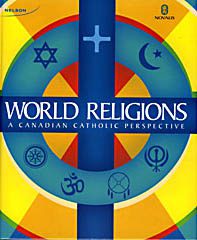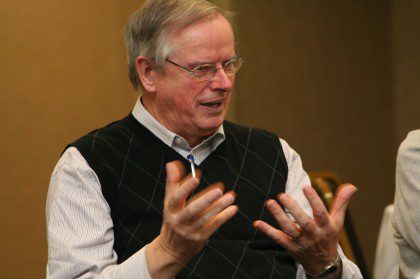 Among the texts that Catholic high school students in Canada will be putting in their book bags this fall is one edited by Fr. John van den Hengel, SCJ. Before being elected to the General Council in Rome in 2009, Fr. John was professor emeritus at St. Paul University in Ottawa and had worked for almost 30 years in the production of religious education resources as theological consultant to the National Office of Religious Education of the Canadian Conference of Catholic Bishops.
Among the texts that Catholic high school students in Canada will be putting in their book bags this fall is one edited by Fr. John van den Hengel, SCJ. Before being elected to the General Council in Rome in 2009, Fr. John was professor emeritus at St. Paul University in Ottawa and had worked for almost 30 years in the production of religious education resources as theological consultant to the National Office of Religious Education of the Canadian Conference of Catholic Bishops.
World Religions: A Canadian Catholic Perspective, makes its debut this fall in Grade 11 religious education classes. Commissioned by the Assembly of Bishops of Ontario, the high school text will be used not only in Ontario but also in other provinces where there are public-funded Catholic schools, such as Alberta and Saskatchewan.
Through the National Office of Religious Education Fr. John had already worked on at least 15 religious education materials. Projects ranged from the pre-school level (In the Image of God, published in 1990) to a Grade 12 project on ethics (In Search of the Good, published in 2004).
“When the educational committee of the Bishops of Ontario mandated to have a new world religions text produced, I let it be known that I was interested to participate,” said Fr. John.
The bishops’ committee asked the Institute of Catholic Education of Toronto to seek proposals from publishing houses that might be interested in taking on the project. “The bishops wanted a Catholic approach to world religions, not a purely descriptive approach,” said Fr. John. “The publishing house Novalis [then owned by St. Paul University] approached me to spearhead their proposal.”
The proposal that Fr. John helped to develop was the one accepted by the bishops in 2007. Soon after, Fr. John found himself on a writing team outlining the specifics of the new text.
A topic as encompassing as “world religions” could easily get unwieldy. Both the school year and a teenager’s attention span are only so long. One of the first tasks of the writing team was to determine which of the enormous number of world religions would be included. How does a text that is to share the vast diversity of religion narrow its focus to only a part of that diversity?

“It was decided that the text would focus only on world religions that are present in Canada to a significant degree,” said Fr. John. This included Christianity, Judaism, Islam, Hinduism, Buddhism, Sikhism and native religions of Canada. “Christianity still constitutes 83% of the Canadian population. All of the other religions in the text make up between 1 and 2% of the population. The fastest growing religion in Canada is Islam.”
The book is unique in that it explores each religion from a Catholic perspective. It compares the “similarities or dissimilarities with Catholicism, but even more so, the sort of interreligious dialogue that exits between Catholicism and the other religion,” he said.
Initially, Fr. John was to write three chapters of the book. However, a few months into the project St. Paul University sold Novalis to Bayard, a major publishing house that belongs to the Assumptionists. In the process, World Religions editor-in-chief, Michael O’Hearn, resigned and moved to the University of Ottawa Press.
Bayard/Novalis asked Fr. John if he would be willing to step in and take on the role of editor-in-chief. He agreed and soon “had a much better appreciation of the work of an editor,” he said. Besides rewriting much of the text submitted, Fr. John also had to ensure that it was accurate and written in a way that would be appropriate in a class setting. To assist with the educational focus, Novalis/Bayard forged an alliance with Nelson Publishing, a major force in Canadian school curricula.
There were six writers for the eleven chapters of the student text. The writers were mostly teachers. “After being edited, all texts were sent to representatives of the various religions treated in the text,” said Fr. John. “They alerted us to a number of sensitive areas in the text or provided us with helpful information. In most cases, the representatives of other religions were very happy with the way their religion was presented in the text. For the chapter on native religions in Canada we consulted with an Ojibwa sister from Northern Ontario.”
An accompanying teacher’s manual was also developed. “This was the responsibility of Sharron McKeever, a retired teacher of the Durham region east of Toronto,” said Fr. John. The teacher’s resource package also includes a multimedia CD with photos, video clips, audio sections and PowerPoint presentations.
Working on the project had significance for Fr. John on several fronts. “Among Catholic theologians but also among Catholics in general, there is a great desire to be open to other religions,” said Fr. John. “But in the desire to be open, positions are taken that do not sufficiently appreciate that the differences among religions are real. Many Catholics say: ‘Don’t we all believe in the same thing?’ And the response is, ‘No, we do not; the focus of Judeo-Christianity is very different from Buddhism or Hinduism.’”
One the other hand, there are also some Catholics who do not see a place for dialogue between religions because they feel that perhaps “there is really nothing in common,” he said.
Fr. John strongly believes that there is space for that dialogue and quotes Pope John Paul II who wrote that if God’s Holy Spirit is present in other religions, we must “welcome every form of the Spirit’s presence with respect and gratitude.” To welcome that form of the Spirit, Catholics must be in dialogue with others.
Fr. John was busy with the final tasks of the World Religions project when he was elected to the General Council in 2009. “In my first year as councilor I spent a lot of time working to complete the project,” he said. At the same time, the General Council was developing its six-year plan for the congregation. His work with the text had a significant influence on him as he worked with fellow councilors and the superior general to develop their plan.
“With the World Religions project I was very much aware of the importance of interreligious dialogue both when we looked at our notion of internationality and as we planned our approach to the sector of missions,” said Fr. John. Reflecting on the SCJs’ General Conference on missions, held in Warsaw in 2006, Fr. John said that he “realized that we had not done enough work on interreligious dialogue when we talked about mission. It is no longer possible today to speak of mission without speaking about dialogue.
“It is also important for our understanding of internationality as a form of being Church today. Our internationality includes our dialogue. For this reason, interreligious dialogue ought to play a much larger role in our work in the countries of Asia. It is, after all, the Asian Bishops at Vatican II who insisted on the inclusion of interreligious dialogue as central to our faith.”
To learn more about, or order a copy of World Religions: A Canadian Catholic Perspective, click here to go to the Novalis site.
